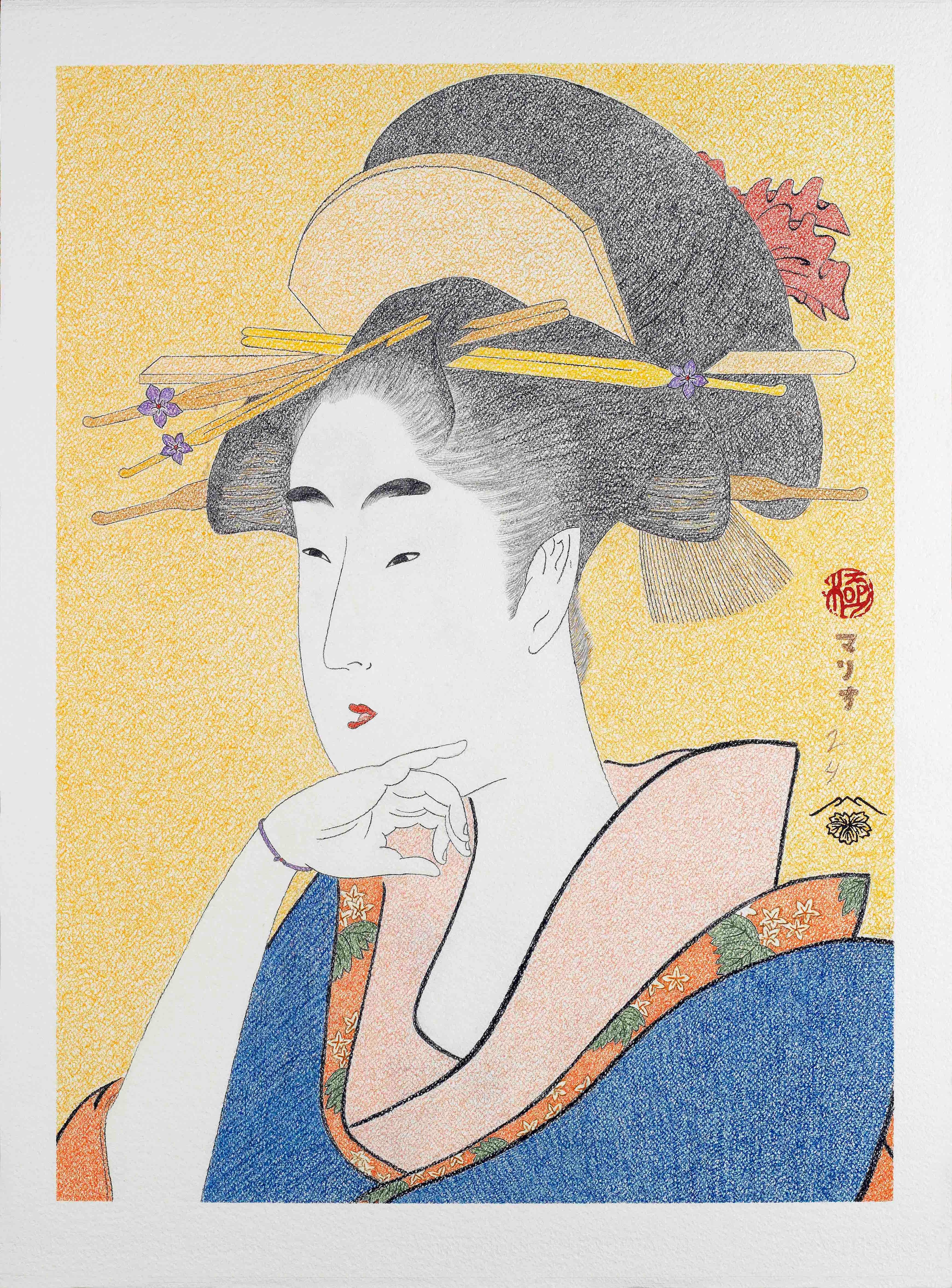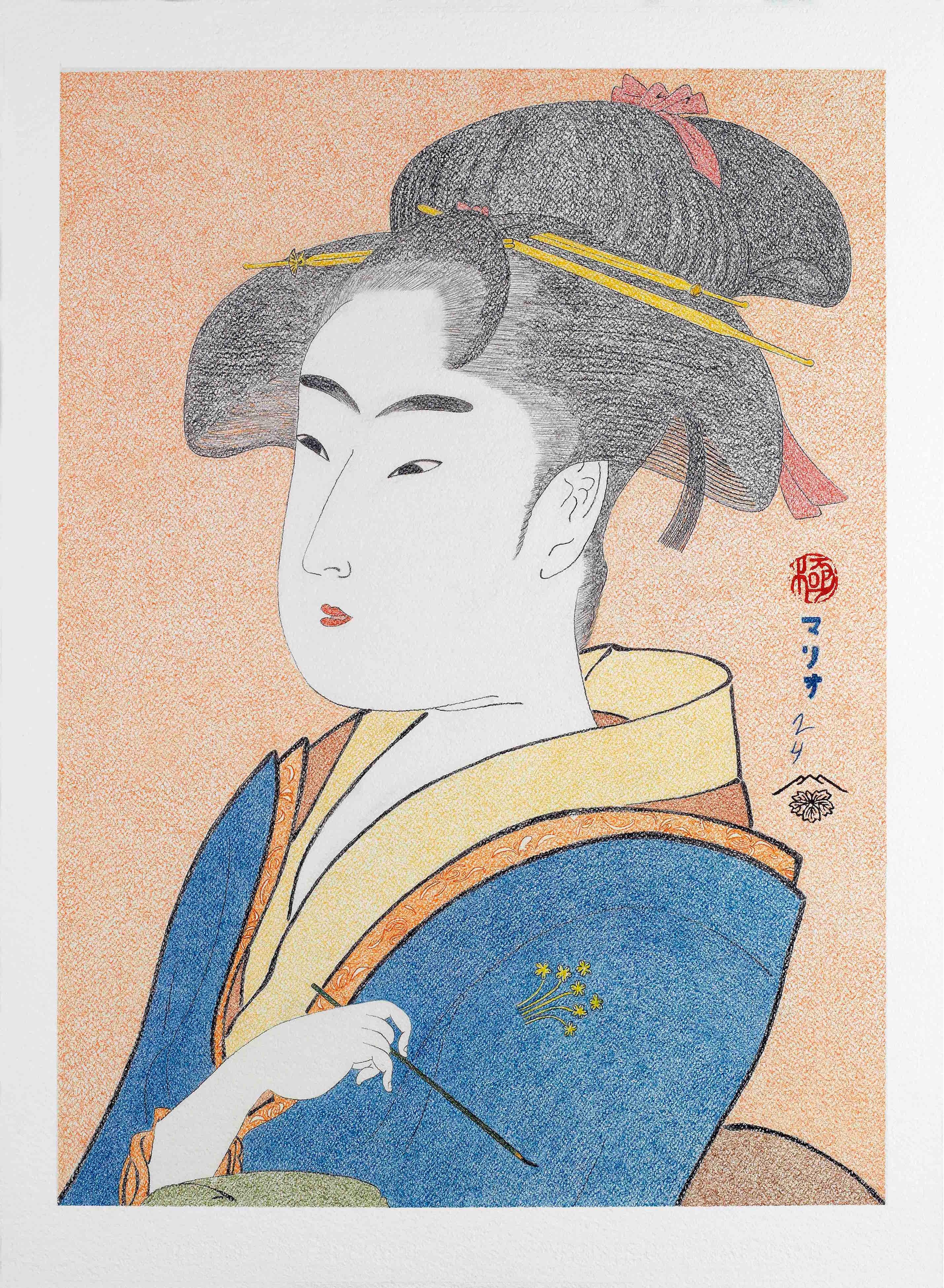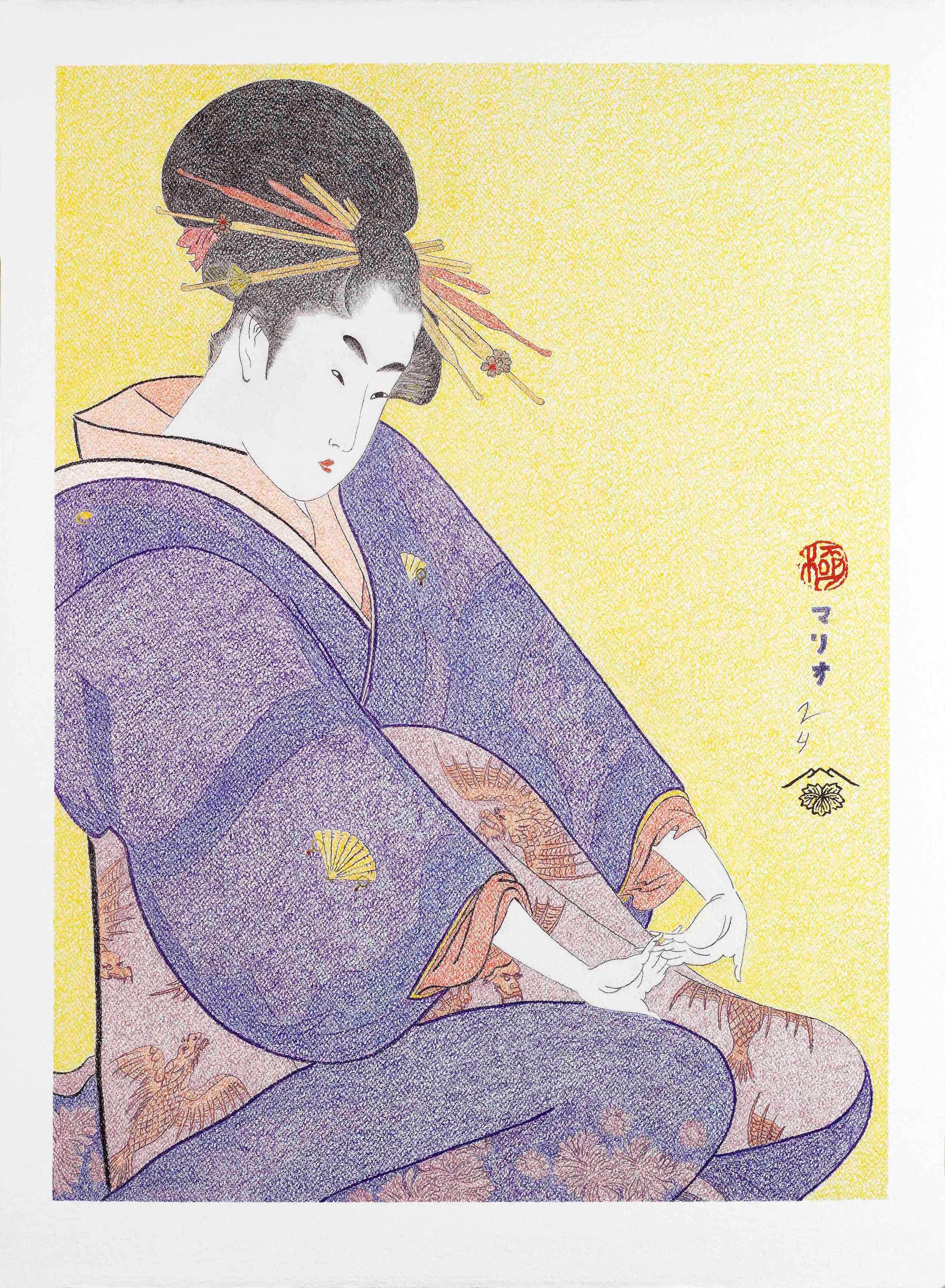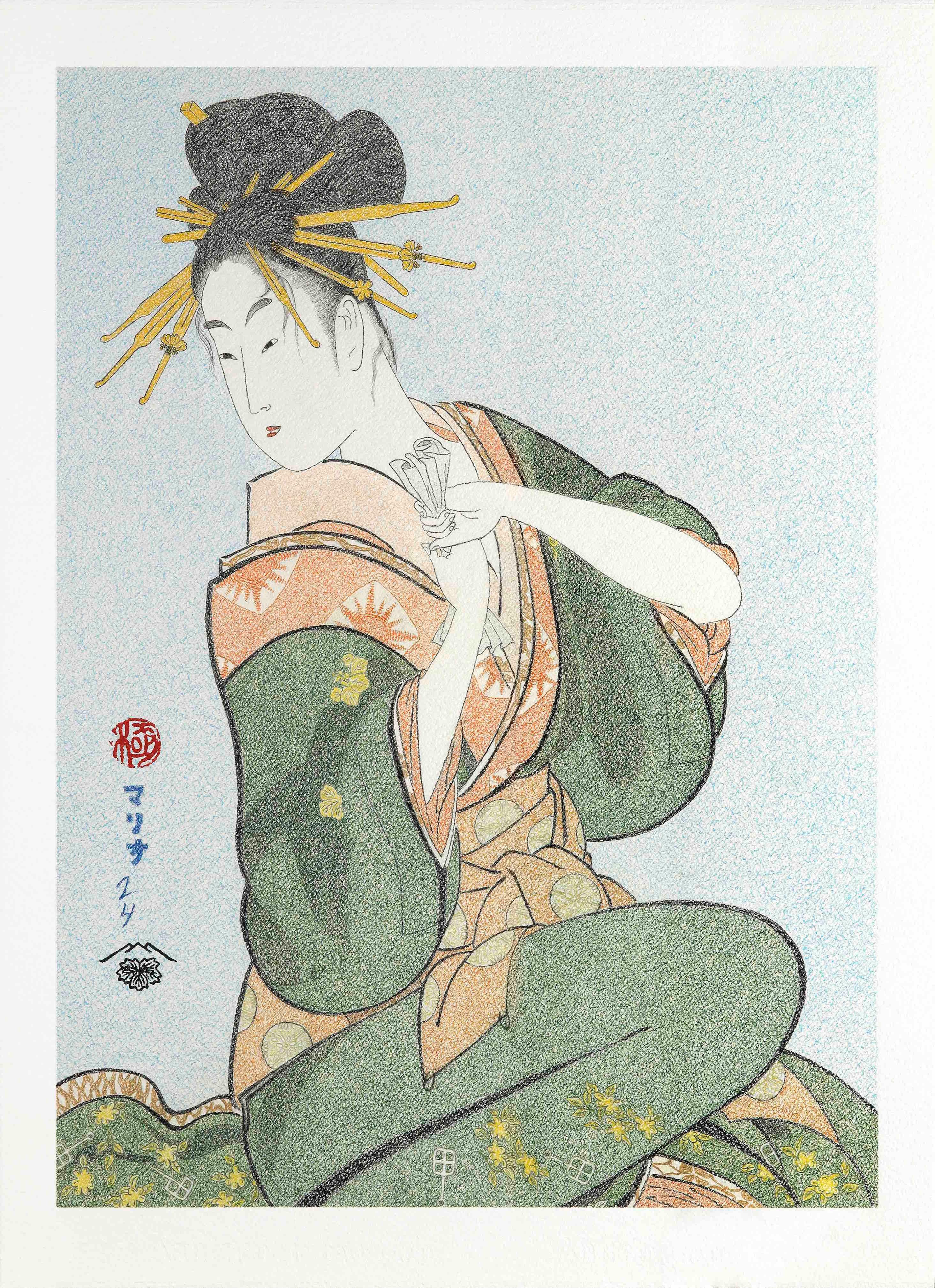Items Similar to Japanese Art Ukiyo-e Figurative Painting, Hitomoto of the Daimonjiya, Edo period
Want more images or videos?
Request additional images or videos from the seller
1 of 13
Mario B. GilJapanese Art Ukiyo-e Figurative Painting, Hitomoto of the Daimonjiya, Edo period2014
2014
About the Item
“Hitomoto of The Daimonjiya in Kyô-Machi Itchôme”
Hitomoto holds a bouquet of flowers looking to her left, with a surprised face, and with her mouth ajar. She seems to be in conversation with another person, while performing the ikebana, or flower arrangement.
The flowers suspended on the top, indicate us that they are in preparation for a celebration.
The drawing of her clear eyes, on her profiled face is particularly highlighted. The bulk of her hairstyle and her long neck stands out on the kimono with geometric figures.
She holds the flowers with a delicate gesture of her little finger.
The lightening of the background in the central part of the sheet contrasts with the darker colors of the hairstyle and kimono, giving vitality to the image
This image is part of the bijin-ga series (“Pretty women”) drawn by Mario BGil, based in the Kitigawa Utamaro woodblock print “Hitomoto of The Daimonjiya in Kyô-Machi Itchôme” (Kamuro Senkaku and Banki, from an untitled series of courtesans compared to flowers), (1802), 35,5 x 24,1 cm. Museum of Fine Arts (Boston-USA).
The artist reproduces the seal of the censor (Kiwame) and from the original publisher (Tsutaya, climbing leaf)), between the two, the signature of Mario BGil written in Japanese, with the date 14 (2014).
The mesaurements of the drawing are 76 x 56 cm. (29,92 x 22,05 in.), with a painted surface of 67 x 49,5 cm. and framed 88 x 67 cm. The frame has a museum glass, which does not reflect. This piece cannot be exported outside of Europe to prevent risks with framing.
With his work on the bijing-ga series, Mario BGil wanted to embellish, give brilliance and volume to the images presented by japanese artist Kitigawa Utamaro in those beautiful engravings, ennobled with the patina of time, which have served as inspiration. The result obtained is almost life-size portraits, endowed with strong chromaticism and valuable contrasts, all enhanced, in turn, with the volume provided by the weight and rigidity of the paper, and its thick texture (Fabriano Artistico “grana grosso”, 640g/m2; the thickness and hardness of the paper makes it necessary to transport it without rolling).
In this way, Mario BGil pays tribute to his admired artist and offers us a new and enriched vision of this popular facet of oriental art from the 18th and 19th centuries.
ABOUT THE ARTIST
Mario BGil is a self-taught artist who for years has combined his creative activity with his work in the business world, away from commercial art galleries. Man of very diverse interests and great artistic sensitivity, studied Art History and in 2012, a deep interest in oriental art was awakened in him so that he began to study the great masters of Japanese Ukiyo-e prints, who had such an influence on the European avant-garde of the late 19th century.
The discovery of Kitagawa Utamaro (1753-1806), a key figure in the metropolitan culture of Edo (now Tokyo), and a point of reference in the history of Japanese engraving, meant for Mario a change of course caused by the imperative need to study his images, recreate them and recreate himself in them, incorporating certain changes in both the format and the technique used.
The technique used by MBG is very different from that used in engravings with wooden blocks impregnated in inks of intense colors that serve as a model. On a paper of heavy weight and thick texture, Mario BGil outlines with a black pencil, and colors the spaces with pencils and watercolors. Faced with the intensity of color of the prints (already very lost in some of them due to their age and exposure to the sun), their drawings are sifted by the streaky white, due to the thick texture of the paper, showing more lines, soft and warmer tones, giving color to the backgrounds but leaving all the volumes corresponding to the skin blank, thus giving the figures a classic serenity that transcends their oriental character.
Between 2014 and 2015, Mario BGil made more than 35 drawings based on the prints selected from the huge amount of work produced by the master Utamaro that shows images of courtesans in different attitudes and poses that highlight the subtle delicacy of oriental feminine beauty.
Kitagawa Utamaro was a faithful representative of the tastes of the Japanese bourgeoisie of its time, which had transformed the life of the cities giving birth to a culture parallel to the official and aristocratic.
The activity of the new rising group took place in special neighborhoods of Edo (Tokyo) and Osaka and its banality, inconsistency and frivolity earned it the name of Ukiyo: "floating world"; a world that will give priority to a series of cultural manifestations much more popular and less intellectualized than those preferred by the nobility. The new neighborhoods are filled with brothels and shows that the upper classes will consider vain, and a new breed of heroes: sumo wrestlers, singers, actors and courtesans will come to reign in this "floating world."
In front of the traditional painting the stamp arises with images of this new world. The courtesans of the pleasure districts of Edo that Utamaro portrays, do not always appear perfectly dressed to receive the client, but are surprised while getting ready, or during the day. He observes them without being seen, spy on them in their daily and intimate work. All of them are women drawn in a similar style, with elongated faces, straight delicate noses (almost a single line) and other features reduced to a mere suggestion (the mouth, a tiny butterfly of red).
The importance that it has had in later European artists (Degas, Toulouse-Lautrec, Bonnard, Gauguin, Van Gogh ...) has been great and Mario BGil has not been able to escape the recreation of those images so classic and, at the same time, so current, paying clear tribute to its original creator.
- Creator:Mario B. Gil (1962)
- Creation Year:2014
- Dimensions:Height: 34.65 in (88 cm)Width: 26.38 in (67 cm)Depth: 1.38 in (3.5 cm)
- Medium:
- Movement & Style:
- Period:
- Condition:The real condition is New, but the artist framed it to have it in his own home. As this piece is framed, it cannot be exported outside of Europe to prevent risks with framing.
- Gallery Location:Segovia, ES
- Reference Number:1stDibs: LU74437971292
About the Seller
5.0
Vetted Seller
These experienced sellers undergo a comprehensive evaluation by our team of in-house experts.
Established in 2002
1stDibs seller since 2017
58 sales on 1stDibs
Typical response time: 4 hours
- ShippingRetrieving quote...Ships From: Bilbao, Spain
- Return PolicyA return for this item may be initiated within 14 days of delivery.
More From This SellerView All
- Japanese Art Ikiyo-e Figurative Painting, Obvious Love Arawaruru Koi, Edo periodLocated in Segovia, ESBIJIN-GA SERIES XVIII (Nº 18) Title: Obvious Love (Arawaruru Koi) This image is part of the bijin-ga series (“Pretty women”) drawn by Mario BGil, based in the Kitigawa Utamaro woodblock print Obvious Love (Arawaruru Koi) (1793-94); 38,8 x 26,2 cm.. Art Institute Chicago, USA. A sensual woman seems to care little that her kimono is open, exposing a breast. Her hair is in disarray , the hairpin at the front about to fall and she holds one of the hairpins in her left hand. She appears to be looking down outside the frame of the picture, perhaps in mid-conversation. The term “arawaruru” refers to a love so wholehearted that it expresses itself in the lover´s face and mannerisms. In the 1780's and 90's the publisher Tsutaya Juzaburo and the designer Kitagawa Utamaro worked together on the production of many woodblock prints, most of them of the bijin-ga type. One of their most popular productions was a set of images that purported to depict psychological classifications of women - 'fickle', 'interesting', etc.. Perhaps in response to this success, they then came up with something similar - a set of prints...Category
2010s Edo Figurative Drawings and Watercolors
MaterialsPaper, Graphite, Crayon, Oil Crayon
- Japanese Art Ukiyo-e Figurative Painting, Bijin Ôkubi, Edo PeriodLocated in Segovia, ESBijin-ga series XXIX (Nº 29) Title: Bijin Ôkubi Upper torso portrait of a Japanese beauty, depicted with a graceful hand gesture and an ornate headdress. Her soft round features contrast with the colourful sharp angles of the collars of her kimono. Her elongated oval face, straight nose and red butterfly lips are typical of the prototype of a beautiful woman, Bijin-ga. Her upper torso and face occupying the central section of the picture show a composition type that became known in time as Large-head pictures, or Okubi-e; compositions with which Utamaro became a model for generations of woodblock artists. This image is part of the Bijin-ga series (“Pretty women”) drawn by Mario BGil, based in the Kitigawa Utamaro woodblock print...Category
2010s Edo Figurative Drawings and Watercolors
MaterialsCrayon, Paper, Oil Crayon, Graphite
- Japanese Art Ukiyo-e Figurative Painting, Tomimoto Toyohina, Edo periodLocated in Segovia, ESBijing-Ga series XXVII (Nº 27) Title: Tomomoto Toyohina Tomimoto Toyohina was a much sought-after geisha (entertainer) who performed narrative ballads accompanied by the shamisen. She was one of several non-prostitute beauties, including teahouse waitresses, whom Utamaro depicted repeatedly in the early to mid 1790s. She appears here with a brush in hand, dressed and combed with simple elegance. This composition is from a six-print series comprising half-length portraits of famous beauties (Famous beauties of Edo). Utamaro elevated Tomimoto Toyohina to the status of one of the three most renowned beauties of her age (together with Okita and Ohisa). She was from a prominent family of musicians that provided entertainment in the Yoshiwara. Toyohina’s appeal undoubtedly was as much due to her appearance as to her skills in singing, and Utamaro’s celebration of her would have further elevated the status of an already well-known lineage. This image is part of the bijin-ga series (“Pretty women”) drawn by Mario BGil, based in the Kitigawa Utamaro woodblock print...Category
2010s Edo Figurative Drawings and Watercolors
MaterialsCrayon, Paper, Oil Crayon, Graphite
- Japanese Art Ukiyo-e Figurative Painting, The courtese Hinakoto, Edo periodLocated in Segovia, ESBijin-ga series XXI (Nº 21) Title: The courtese Hinakoto of the Hyôgorô House of Edo The courtesan Hinakoto is depicted by smoking tobacco. She takes the pipe delicately in her left hand and, in her right hand, she seems to be holding a “uchiwa” (rigid hand fan) that comes out from the bottom of the drawing, decorated with written calligraphy. Some strands of hair that fall on her temple and her scant clothing show that the painter has surprised her in a relaxed moment in which she does not lose her elegance and slenderness. This image is part of the bijin-ga series (“Pretty women”) drawn by Mario BGil, based in the Kitigawa Utamaro woodblock print...Category
2010s Edo Figurative Drawings and Watercolors
MaterialsCrayon, Paper, Oil Crayon, Graphite
- Japanese Art Ukiyo-e Figurative Painting, Hanamurasaki of the Tamaya, Edo periodLocated in Segovia, ESPortrait of the top-class courtesan Hanamurasaki elegantly combed, and dressed in a simple formal kimono and obi, adorned with symbols of her okiya. She is sitting on her knees in a graceful pose, stretching her arms forward and crossing her fingers with a delicate movement of the wrists. This image is part of the “bijin-ga series” (Pretty women) drawn by Mario BGil, based in the Kitigawa Utamaro woodblock print “Hanamurasaky of the Tamaya”, (from the series: “Array of supreme beauties of the Present Day”, 1794), 36,2 x 25 cm. Museum of Fine Arts. Boston, USA. The artist reproduces the seal of the censor (Kiwame) and from the original publisher ("Tsutaya", climbing leaf)), between the two, the signature of Mario BGil written in Japanese, with the date 14 (2014). The mesaurements of the drawing are 76 x 56 cm. (29,92 x 22,05 in.), with a painted surface of 67 x 49,5 cm. With his work on the "bijing-ga series", Mario BGil wanted to embellish, give brilliance and volume to the images presented by japanese artist Kitigawa Utamaro in those beautiful engravings, ennobled with the patina of time, which have served as inspiration. The result obtained is almost life-size portraits, endowed with strong chromaticism and valuable contrasts, all enhanced, in turn, with the volume provided by the weight and rigidity of the paper, and its thick texture (Fabriano Artistico “grana grosso”, 640g/m2; the thickness and hardness of the paper makes it necessary to transport it without rolling). In this way, Mario BGil pays tribute to his admired artist and offers us a new and enriched vision of this popular facet of oriental art from the 18th and 19th centuries. ABOUT THE ARTIST Mario BGil is a self-taught artist who for years has combined his creative activity with his work in the business world, away from commercial art galleries. Man of very diverse interests and great artistic sensitivity, studied Art History and in 2012, a deep interest in oriental art was awakened in him so that he began to study the great masters of Japanese Ukiyo-e prints, who had such an influence on the European avant-garde of the late 19th century. The discovery of Kitagawa Utamaro (1753-1806), a key figure in the metropolitan culture of Edo (now Tokyo), and a point of reference in the history of Japanese engraving...Category
2010s Edo Figurative Drawings and Watercolors
MaterialsCrayon, Paper, Oil Crayon, Graphite
- Japanese Art Ukiyo-e Figurative Painting, Hanazuma of the Hyôgaya HouseLocated in Segovia, ESHanazuma, a beautiful high-class courtesan of the Hyôgaya House, appears sitting sideways on her legs, twisting a letter between her hands at the height of her heart. It is perhaps its message that makes her throw her head back with a beautiful turn of her entire body allowing us to contemplate the frontal details of her kimono and her obi, in green and orange, with beautiful ornaments. This image is part of the “bijin-ga” series (Pretty women) drawn by Mario BGil, based in the Kitigawa Utamaro woodblock print “Hanazuma of the Hyôgaya House”, (1794), 38,8 x 25,9 cm. The Japan Ukiyo-e Museum. Matsumoto, Japan. The artist reproduces the seal of the censor (Kiwame) and from the original publisher (“Tsutaya”, climbing leaf)), between the two, the signature of Mario BGil written in Japanese, with the date 14 (2014). The mesaurements of the drawing are 76 x 56 cm. (29,92 x 22,05 in.), with a painted surface of 67 x 49,5 cm. With his work on the bijing-ga series, Mario BGil wanted to embellish, give brilliance and volume to the images presented by japanese artist Kitigawa Utamaro in those beautiful engravings, ennobled with the patina of time, which have served as inspiration. The result obtained is almost life-size portraits, endowed with strong chromaticism and valuable contrasts, all enhanced, in turn, with the volume provided by the weight and rigidity of the paper, and its thick texture (Fabriano Artistico “grana grosso”, 640g/m2; the thickness and hardness of the paper makes it necessary to transport it without rolling). In this way, Mario BGil pays tribute to his admired artist and offers us a new and enriched vision of this popular facet of oriental art from the 18th and 19th centuries. ABOUT THE ARTIST Mario BGil is a self-taught artist who for years has combined his creative activity with his work in the business world, away from commercial art galleries. Man of very diverse interests and great artistic sensitivity, studied Art History and in 2012, a deep interest in oriental art was awakened in him so that he began to study the great masters of Japanese Ukiyo-e prints, who had such an influence on the European avant-garde of the late 19th century. The discovery of Kitagawa Utamaro (1753-1806), a key figure in the metropolitan culture of Edo (now Tokyo), and a point of reference in the history of Japanese engraving...Category
2010s Edo Figurative Drawings and Watercolors
MaterialsCrayon, Paper, Oil Crayon, Graphite
You May Also Like
- "Veneer" Figurative Drawing, Color Pencil, Ballpoint Pen, GraphiteBy Lauren RinaldiLocated in Philadelphia, PA"Veneer" is an original oil pastel, ballpoint pen, color pencil, and graphite on arches paper work by Lauren Rinaldi. This piece ships in the pictured archival custom frame. The pape...Category
21st Century and Contemporary Contemporary Figurative Drawings and Water...
MaterialsArchival Paper, Oil Pastel, Ballpoint Pen, Color Pencil, Graphite
- "March Avery in Beret, " Milton Avery, American Modernism, Portrait of ArtistBy Milton AveryLocated in New York, NYMilton Clark Avery (1885 - 1965) March Avery in a Beret, 1951 Black crayon and graphite on cream wove paper 11 x 8 3/8 inches Signed and dated lower left; ...Category
1950s American Modern Portrait Drawings and Watercolors
MaterialsPaper, Crayon, Pencil, Graphite
- "Truer Than True" ballpoint pen, figurative portraitBy Lauren RinaldiLocated in Philadelphia, PAOriginal drawing by Lauren Rinaldi float mounted in the pictured simple white frame measuring 17in x 14in. Lauren Rinaldi works using unbiased portraits of women’s bodies as a veh...Category
21st Century and Contemporary Contemporary Portrait Drawings and Waterco...
MaterialsBallpoint Pen, Archival Paper, Graphite, Oil Pastel
- Young boy at Loemboeng, 1918Located in Amsterdam, NLYoung boy at Loemboeng, 1918 Signed with initials and dated, bottom right Black chalk on paper, 25.7 x 10 cm Literature: W.O.J. Nieuwenkamp, Zwerftochten door Timor en Onderhoori...Category
1910s Art Nouveau Portrait Drawings and Watercolors
MaterialsPaper, Graphite
- "Drawing for Allegheny + Ludlum Helmet & Jacket, " Graphite on Paper, 2020Located in Chicago, ILEntitled "Drawing for Allegheny + Ludlum Helmet & Jacket," this work by Chicago-based artist Patrick Fitzgerald is a companion piece to his sculpture "A+L Helmet & Jacket." Worn by the imagined driver of one of his miniature soap box derby cars, each helmet & jacket is branded with an industrial sponsor, in this case the Allegheny Ludlum Corporation, a steel manufacturer from the early 20th century. Mounted on subtle collage materials and paper fragments...Category
21st Century and Contemporary Outsider Art Figurative Drawings and Water...
MaterialsPaper, Board, Graphite
- Winged character Geneviève Seillé Contemporary art drawing outsider art portraitBy Geneviève SeilléLocated in Paris, FRMixed media drawing on paper Dated and signed on the back In the plastic work of Geneviève Seillé, the word, like a sign, reigns supreme. An object o...Category
Early 2000s Outsider Art Figurative Drawings and Watercolors
MaterialsPaper, Color Pencil, Graphite





